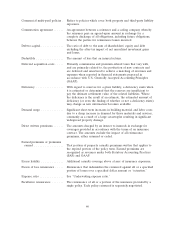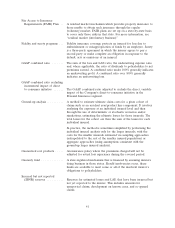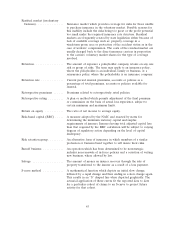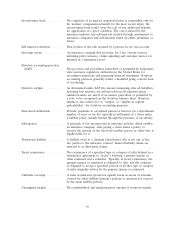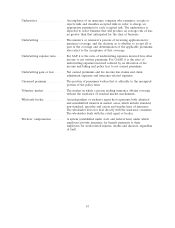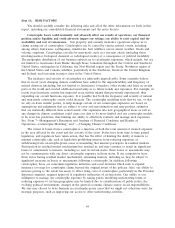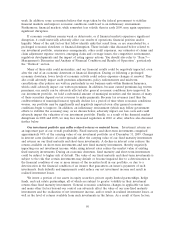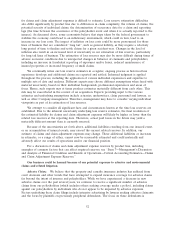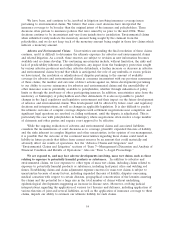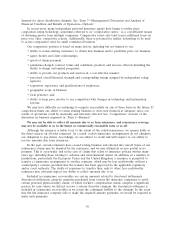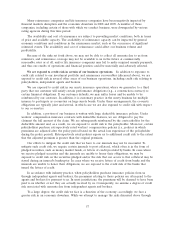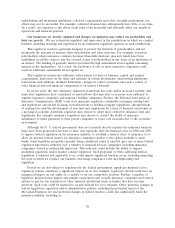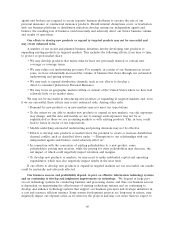Travelers 2009 Annual Report Download - page 62
Download and view the complete annual report
Please find page 62 of the 2009 Travelers annual report below. You can navigate through the pages in the report by either clicking on the pages listed below, or by using the keyword search tool below to find specific information within the annual report.weak. In addition, some economists believe that steps taken by the federal government to stabilize
financial markets and improve economic conditions could lead to an inflationary environment.
Furthermore, financial markets, while somewhat less volatile than in early 2009, may again experience
significant disruption.
If economic conditions remain weak or deteriorate, or if financial markets experience significant
disruption, it could materially adversely affect our results of operations, financial position and/or
liquidity. Many of the risk factors that follow identify risks that result from, or are exacerbated by, a
prolonged economic slowdown or financial disruption. These include risks discussed below related to
our investment portfolio, reinsurance arrangements, other credit exposures, our estimates of claims and
claim adjustment expense reserves, emerging claim and coverage issues, the competitive environment,
regulatory developments and the impact of rating agency actions. You should also refer to ‘‘Item 7—
Management’s Discussion and Analysis of Financial Condition and Results of Operation’’, particularly
the ‘‘Outlook’’ section.
Many of these risks could materialize, and our financial results could be negatively impacted, even
after the end of an economic downturn or financial disruption. During or following a prolonged
economic downturn, lower levels of economic activity could reduce exposure changes at renewal. They
also could adversely impact audit premium adjustments, policy endorsements and mid-term
cancellations after policies are written, particularly in our business units within Business Insurance,
which could adversely impact our written premiums. In addition, because earned premiums lag written
premiums, our results can be adversely affected after general economic conditions have improved. In
our investment portfolio, we hold a substantial amount of municipal securities and the issuers of many
of these securities depend on tax revenues to make payments. Because tax revenues (and thus the
creditworthiness of municipal issuers) typically decline for a period of time when economic conditions
worsen, our portfolio may be significantly and negatively impacted even after general economic
conditions begin to improve. In addition, an inflationary environment (which may follow government
efforts to stabilize the economy) may, as we discuss below, adversely impact our loss costs and could
adversely impact the valuation of our investment portfolio. Finally, as a result of the financial market
disruptions in 2008 and 2009, we may face increased regulation in 2010 or after, which is also discussed
further below.
Our investment portfolio may suffer reduced returns or material losses. Investment returns are
an important part of our overall profitability. Fixed maturity and short-term investments comprised
approximately 94% of the carrying value of our investment portfolio as of December 31, 2009. Changes
in interest rates (inclusive of credit spreads) affect the carrying value of our fixed maturity investments
and returns on our fixed maturity and short-term investments. A decline in interest rates reduces the
returns available on short-term investments and new fixed maturity investments, thereby negatively
impacting our net investment income, while rising interest rates reduce the market value of existing
fixed maturity investments. During an economic downturn, fixed maturity and short-term investments
could be subject to higher risk of default. The value of our fixed maturity and short-term investments is
subject to the risk that certain investments may default or become impaired due to a deterioration in
the financial condition of one or more issuers of the securities held in our portfolio, or due to a
deterioration in the financial condition of an insurer that guarantees an issuer’s payments of such
investments. Such defaults and impairments could reduce our net investment income and result in
realized investment losses.
We invest a portion of our assets in equity securities, private equity limited partnerships, hedge
funds, and real estate partnerships, all of which are subject to greater volatility in their investment
returns than fixed maturity investments. General economic conditions, changes in applicable tax laws
and many other factors beyond our control can adversely affect the value of our non-fixed maturity
investments and the realization of net investment income, and/or result in realized investment losses, as
well as the level of returns available from such investments in the future. As a result of these factors,
50


